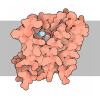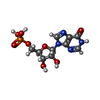+ Open data
Open data
- Basic information
Basic information
| Entry | Database: PDB / ID: 9dmu | ||||||||||||
|---|---|---|---|---|---|---|---|---|---|---|---|---|---|
| Title | Cryo-EM structure of IMPDH2 bound to IMP and GAD | ||||||||||||
 Components Components | Inosine-5'-monophosphate dehydrogenase 2 | ||||||||||||
 Keywords Keywords | OXIDOREDUCTASE / dehydrogenase / substrate / inhibitor | ||||||||||||
| Function / homology |  Function and homology information Function and homology information'de novo' XMP biosynthetic process / Purine ribonucleoside monophosphate biosynthesis / lymphocyte proliferation / IMP dehydrogenase / IMP dehydrogenase activity / GMP biosynthetic process / Azathioprine ADME / peroxisomal membrane / GTP biosynthetic process / cellular response to interleukin-4 ...'de novo' XMP biosynthetic process / Purine ribonucleoside monophosphate biosynthesis / lymphocyte proliferation / IMP dehydrogenase / IMP dehydrogenase activity / GMP biosynthetic process / Azathioprine ADME / peroxisomal membrane / GTP biosynthetic process / cellular response to interleukin-4 / circadian rhythm / secretory granule lumen / ficolin-1-rich granule lumen / Potential therapeutics for SARS / nucleotide binding / Neutrophil degranulation / DNA binding / RNA binding / extracellular exosome / extracellular region / metal ion binding / nucleus / membrane / cytoplasm / cytosol Similarity search - Function | ||||||||||||
| Biological species |  Homo sapiens (human) Homo sapiens (human) | ||||||||||||
| Method | ELECTRON MICROSCOPY / single particle reconstruction / cryo EM / Resolution: 1.82 Å | ||||||||||||
 Authors Authors | Chen, Y.J. / Li, B. / Parada, L.F. | ||||||||||||
| Funding support |  United States, 3items United States, 3items
| ||||||||||||
 Citation Citation |  Journal: Nature / Year: 2024 Journal: Nature / Year: 2024Title: Gliocidin is a nicotinamide-mimetic prodrug that targets glioblastoma. Authors: Yu-Jung Chen / Swathi V Iyer / David Chun-Cheng Hsieh / Buren Li / Harold K Elias / Tao Wang / Jing Li / Mungunsarnai Ganbold / Michelle C Lien / Yu-Chun Peng / Xuanhua P Xie / Chenura D ...Authors: Yu-Jung Chen / Swathi V Iyer / David Chun-Cheng Hsieh / Buren Li / Harold K Elias / Tao Wang / Jing Li / Mungunsarnai Ganbold / Michelle C Lien / Yu-Chun Peng / Xuanhua P Xie / Chenura D Jayewickreme / Marcel R M van den Brink / Sean F Brady / S Kyun Lim / Luis F Parada /   Abstract: Glioblastoma is incurable and in urgent need of improved therapeutics. Here we identify a small compound, gliocidin, that kills glioblastoma cells while sparing non-tumour replicative cells. ...Glioblastoma is incurable and in urgent need of improved therapeutics. Here we identify a small compound, gliocidin, that kills glioblastoma cells while sparing non-tumour replicative cells. Gliocidin activity targets a de novo purine synthesis vulnerability in glioblastoma through indirect inhibition of inosine monophosphate dehydrogenase 2 (IMPDH2). IMPDH2 blockade reduces intracellular guanine nucleotide levels, causing nucleotide imbalance, replication stress and tumour cell death. Gliocidin is a prodrug that is anabolized into its tumoricidal metabolite, gliocidin-adenine dinucleotide (GAD), by the enzyme nicotinamide nucleotide adenylyltransferase 1 (NMNAT1) of the NAD salvage pathway. The cryo-electron microscopy structure of GAD together with IMPDH2 demonstrates its entry, deformation and blockade of the NAD pocket. In vivo, gliocidin penetrates the blood-brain barrier and extends the survival of mice with orthotopic glioblastoma. The DNA alkylating agent temozolomide induces Nmnat1 expression, causing synergistic tumour cell killing and additional survival benefit in orthotopic patient-derived xenograft models. This study brings gliocidin to light as a prodrug with the potential to improve the survival of patients with glioblastoma. | ||||||||||||
| History |
|
- Structure visualization
Structure visualization
| Structure viewer | Molecule:  Molmil Molmil Jmol/JSmol Jmol/JSmol |
|---|
- Downloads & links
Downloads & links
- Download
Download
| PDBx/mmCIF format |  9dmu.cif.gz 9dmu.cif.gz | 1.1 MB | Display |  PDBx/mmCIF format PDBx/mmCIF format |
|---|---|---|---|---|
| PDB format |  pdb9dmu.ent.gz pdb9dmu.ent.gz | Display |  PDB format PDB format | |
| PDBx/mmJSON format |  9dmu.json.gz 9dmu.json.gz | Tree view |  PDBx/mmJSON format PDBx/mmJSON format | |
| Others |  Other downloads Other downloads |
-Validation report
| Summary document |  9dmu_validation.pdf.gz 9dmu_validation.pdf.gz | 2.1 MB | Display |  wwPDB validaton report wwPDB validaton report |
|---|---|---|---|---|
| Full document |  9dmu_full_validation.pdf.gz 9dmu_full_validation.pdf.gz | 2.1 MB | Display | |
| Data in XML |  9dmu_validation.xml.gz 9dmu_validation.xml.gz | 97.8 KB | Display | |
| Data in CIF |  9dmu_validation.cif.gz 9dmu_validation.cif.gz | 141.3 KB | Display | |
| Arichive directory |  https://data.pdbj.org/pub/pdb/validation_reports/dm/9dmu https://data.pdbj.org/pub/pdb/validation_reports/dm/9dmu ftp://data.pdbj.org/pub/pdb/validation_reports/dm/9dmu ftp://data.pdbj.org/pub/pdb/validation_reports/dm/9dmu | HTTPS FTP |
-Related structure data
| Related structure data |  47016MC M: map data used to model this data C: citing same article ( |
|---|---|
| Similar structure data | Similarity search - Function & homology  F&H Search F&H Search |
- Links
Links
- Assembly
Assembly
| Deposited unit | 
|
|---|---|
| 1 |
|
- Components
Components
| #1: Protein | Mass: 56233.242 Da / Num. of mol.: 8 Source method: isolated from a genetically manipulated source Source: (gene. exp.)  Homo sapiens (human) / Gene: IMPDH2, IMPD2 / Production host: Homo sapiens (human) / Gene: IMPDH2, IMPD2 / Production host:  #2: Chemical | ChemComp-IMP / #3: Chemical | ChemComp-A1A7T / [[( Mass: 746.557 Da / Num. of mol.: 8 / Source method: obtained synthetically / Formula: C25H30N7O14P2S / Feature type: SUBJECT OF INVESTIGATION #4: Chemical | ChemComp-K / #5: Water | ChemComp-HOH / | Has ligand of interest | Y | Has protein modification | N | |
|---|
-Experimental details
-Experiment
| Experiment | Method: ELECTRON MICROSCOPY |
|---|---|
| EM experiment | Aggregation state: PARTICLE / 3D reconstruction method: single particle reconstruction |
- Sample preparation
Sample preparation
| Component | Name: Ternary complex of IMPDH2 bound to IMP and GAD / Type: COMPLEX / Entity ID: #1 / Source: RECOMBINANT | ||||||||||||||||||||
|---|---|---|---|---|---|---|---|---|---|---|---|---|---|---|---|---|---|---|---|---|---|
| Source (natural) | Organism:  Homo sapiens (human) Homo sapiens (human) | ||||||||||||||||||||
| Source (recombinant) | Organism:  | ||||||||||||||||||||
| Buffer solution | pH: 8 | ||||||||||||||||||||
| Buffer component |
| ||||||||||||||||||||
| Specimen | Conc.: 1 mg/ml / Embedding applied: NO / Shadowing applied: NO / Staining applied: NO / Vitrification applied: YES | ||||||||||||||||||||
| Specimen support | Details: PELCO easiGlow Glow Discharge Cleaning System / Grid material: GOLD / Grid type: Quantifoil R1.2/1.3 | ||||||||||||||||||||
| Vitrification | Instrument: FEI VITROBOT MARK IV / Cryogen name: ETHANE / Humidity: 96 % / Chamber temperature: 289 K |
- Electron microscopy imaging
Electron microscopy imaging
| Experimental equipment |  Model: Titan Krios / Image courtesy: FEI Company |
|---|---|
| Microscopy | Model: TFS KRIOS |
| Electron gun | Electron source:  FIELD EMISSION GUN / Accelerating voltage: 300 kV / Illumination mode: FLOOD BEAM FIELD EMISSION GUN / Accelerating voltage: 300 kV / Illumination mode: FLOOD BEAM |
| Electron lens | Mode: BRIGHT FIELD / Nominal magnification: 29000 X / Nominal defocus max: 1600 nm / Nominal defocus min: 600 nm |
| Image recording | Electron dose: 66 e/Å2 / Film or detector model: GATAN K3 (6k x 4k) |
- Processing
Processing
| EM software |
| ||||||||||||||||||||||||||||||||||||
|---|---|---|---|---|---|---|---|---|---|---|---|---|---|---|---|---|---|---|---|---|---|---|---|---|---|---|---|---|---|---|---|---|---|---|---|---|---|
| CTF correction | Type: PHASE FLIPPING AND AMPLITUDE CORRECTION | ||||||||||||||||||||||||||||||||||||
| Symmetry | Point symmetry: D4 (2x4 fold dihedral) | ||||||||||||||||||||||||||||||||||||
| 3D reconstruction | Resolution: 1.82 Å / Resolution method: FSC 0.143 CUT-OFF / Num. of particles: 876343 / Symmetry type: POINT | ||||||||||||||||||||||||||||||||||||
| Atomic model building | Protocol: RIGID BODY FIT / Space: REAL | ||||||||||||||||||||||||||||||||||||
| Atomic model building | PDB-ID: 6U8E Accession code: 6U8E / Source name: PDB / Type: experimental model | ||||||||||||||||||||||||||||||||||||
| Refine LS restraints |
|
 Movie
Movie Controller
Controller



 PDBj
PDBj






